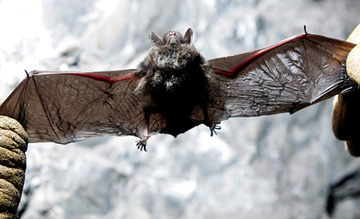
|  |  |  Editorials | Environmental | June 2009 Editorials | Environmental | June 2009  
Experts: Bat Fungus Causing Historic Decline
 NPR NPR
go to original
June 07, 2009


| | Scott Crocoll holds a dead Indiana bat in an abandoned mine in Rosendale, N.Y., in January. (Mike Groll/AP) |  |
A mysterious fungus attacking America's bats could spread nationwide within years and represents the most serious threat to wildlife in a century, US experts warned Congress this week.

Displaying pictures of bats speckled with the white fungus that gave the disease its name — white-nose syndrome — experts described to two House subcommittees Thursday the horror of discovering caves where bats had been decimated by the disease.

As a state wildlife biologist from Vermont put it, one cave there was turned into a morgue, with bats freezing to death outside and so many carcasses littering the cave's floor the stench was too strong for researchers to enter.

They also warned that if nothing more is done to stop its spread, the fungus could strike caves and mines with some of the largest and most endangered populations of hibernating bats in the United States.

At stake is the loss of an insect-eating machine. The six species of bats that have so far been stricken by the fungus can eat up to their body weight in insects a night, reducing insects that destroy crops, forests and carry disease such as West Nile virus.

"We are witnessing one of the most precipitous declines of wildlife in North America," said Thomas Kunz, director of the Center for Ecology and Conservation Biology at Boston University, who said that between $10 million and $17 million is needed to launch a national research program into the fungus.

Merlin Tuttle, a world-renowned bat expert and president of Bat Conservation International in Austin, Texas, said that white-nose syndrome was probably the most serious threat to wildlife in the past century. He also called for more research to determine its cause and how it was being spread.

"Never in my wildest imagination had I dreamed of anything that could pose this serious a threat to America's bats," Tuttle told the panel. "This is the most alarming event in the lifetime of a person who has devoted his life to recovering these populations."

Since it was first discovered in a cave west of Albany, N.Y., in March 2007, white-nose syndrome has spread to 65 caves in nine states, turning up last winter in West Virginia and Virginia, federal wildlife officials said. There are also several caves suspected of harboring the fungus in Canada.

To date it has killed between 500,000 to 1 million bats, mostly common species. But what has wildlife officials concerned is the fungus looks to be on the verge of entering the Southeast and Midwest, where some of the most endangered and largest populations of bats live. The fungus is known to occur in caves used by the Virginia big-eared bat, which has a population of only 20,000.

"If it goes farther, we are going to see some serious bat issues," said Marvin Moriarty, acting deputy director of the Fish and Wildlife Service. "If it makes that jump, we have a real problem."

The Interior Department and Forest Service have so far spent $5 million researching the problem, closed caves to people on forest lands in 33 states and urged the public not to enter caves or abandoned mines in states with white-nose syndrome. While there is no evidence the people can be harmed by the fungus, they may be contributing to its spread.

There is also a plan in place to start raising the Virginia big-eared bat in captivity to prevent its extinction if and when the fungus strikes that species.

But some lawmakers Thursday wondered if that was enough.

"The severe mortality and sudden spread of white-nose syndrome demonstrates the need for a rapid response beyond closing caves where bats live," said Del. Madeleine Z. Bordallo, D-Guam, who said the syndrome "could be an ecological and economic disaster if it remains unchecked."

One possible consequence of the syndrome's toll on bats is increased used of pesticides to control inspect populations, Moriarty said.

The fungus attacks bats during winter hibernation, when they are most vulnerable and their temperature is lowered so they can last through the winter on the fat they've put on by feasting on insects. Research has shown that the fungus thrives in cold temperatures and the densities of bats huddled on the ceilings and walls of cave likely help it to spread.

How exactly the fungus kills bats is poorly understood, but once the fungus attaches it invades tissues. The bat then fidgets, burning up its excess energy. Most simply starve and die, others leave the cave prematurely to look for nonexistent food in the winter and perish.

"I went into a cave last spring and most damn near cried," Moriarty said in an interview after the House panel.

There were supposed to be 3,000 bats in the cave, the Greeley mine in Vermont. Moriarty and his colleagues could only find 33.

"And I don't think a single bat was going to make it out of the cave," he said. |

 |
|  |



